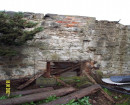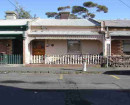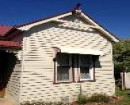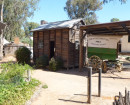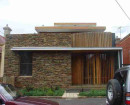Alexandra (College) House
Milton Street and Brown Street HAMILTON, Southern Grampians Shire
Melville Oval Precinct Hamilton
-
Add to tour
You must log in to do that.
-
Share
-
Shortlist place
You must log in to do that.
- Download report


Statement of Significance
SIGNIFICANCE: »Built as the girls' equivalent of the Hamilton and Western District College to a design by the leading Melbourne architects, Ellerker & Kilburn. Key building in streetscape
STATEMENT OF SIGNIFICANCE
Alexandra College
Milton Street/Brown Street
The original home of the Alexandra College for Ladies is of regional significance both for its historical associations and for its architecture. The College opened in 1872 and moved into this building in 1874, with the intention of providing excellent instruction to the young ladies of both town and country. It has historical importance as a high quality Western District Girls' College attended by the daughters of leading regional townspeople and the rural gentry. It provided a secondary education for a privileged few at a time when the state system only catered for a primary education. ([i])
The College was amalgamated with its brother school, the Hamilton and Western District College in 1962. The Boys' College had been taken over by the Presbyterian Church in 1954. Both original buildings were designed by the leading Melbourne architect, W H Elleker. As with Hamilton College, their original design was never completed with the end pavilions and their bay windows being replaced by smaller wings. Alexandra College was described as "Early Italian" in style and this is suggested in the full original design with its tower, bracketed eaves, aedicule windows and picturesque position. The English born William Henry Ellerker trained in Melbourne under Messrs Kemp, Knight and Kerr, one of the most important early architectural firms. ([ii]) The eminence of their private and commercial clients, shows how well connected and successful Elleker and his later partner E G Kilburn became. ([iii])
The building was disposed of by the Presbyterian Church in 1972 at first being used as offices and then as the Alexandra House Reception Rooms. ([iv]) The building has been compromised both by unsympathetic additions and alterations and by the construction of flats in the former front garden. It is in fair condition. This, more than any other single incident, triggered a concern about the lack of conservation planning controls in Hamilton and lead to the present study.
[i] Garden, D, Hamilton, pp 90, 91; The First 100 Years, St Andrew's Presbyterian Church, Hamilton, 1954, (unpaginated); Vision and Realisation, vol II, p 132.
[ii] The front door of Hamilton College should be compared with Knight & Kerr's Mannerist entrance to D'Estaville, 7 Barry St, Kew 0f 1858.
[iii] Sutherland, A, Victoria & Its Metropolis, Vol 11B, p 516.
[iv] Garden, Don, Hamilton, p 238.
-
-
Alexandra (College) House - Physical Description 1
MATERIALS:
Roof: »slate?
Walls: »rendered brick
Dressings: »cement render
Plinth: »rock face bluestone
Windows: »4 pane dhs
Paving: »gravel
Other: »dressed bluestone steps timber bracketed eaves cast iron downpipesAlexandra (College) House - Physical Description 2
NOTABLE FEATURES:»blank foundation stone; proposed tower never built nor the northern half of the building.
Alexandra (College) House - Integrity
INTEGRITY:F
CONDITION:F
Alexandra (College) House - Historical Australian Themes
ASSOCIATED HISTORIC THEMES
Education: Girls' education
The Role of Women: Girls' education
Religion: PresbyterianismHeritage Study and Grading
Southern Grampians - City of Hamilton Conservation Study
Author: Timothy Hubbard with Carlotta Kellaway & Michael Looker (plus Francis Punch)
Year: 1991
Grading: B
-
-
-
-
-
MECHANICS INSTITUTE
 Victorian Heritage Register H2171
Victorian Heritage Register H2171 -
FORMER HAMILTON TUBERCULOSIS CHALET
 Victorian Heritage Register H1066
Victorian Heritage Register H1066 -
Botanic Gardens Precinct Hamilton
 Southern Grampians Shire
Southern Grampians Shire
-
'Boonderoo', House and Outbuildings
 Greater Bendigo City
Greater Bendigo City -
'Riverslea' house
 Greater Bendigo City
Greater Bendigo City -
1 Adam Street
 Yarra City
Yarra City
-
-
Notes See all notes
rohan storey • 06/11/19
The architect was W H Ellerker, not Elleker. The latter spelling occurs a few times in contemporary reports on his works, but the vast majority use the former spelling.
Public contributions
Notes See all notes
rohan storey • 06/11/19
The architect was W H Ellerker, not Elleker. The latter spelling occurs a few times in contemporary reports on his works, but the vast majority use the former spelling.





